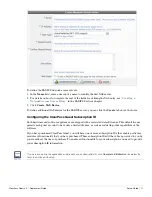
54
| Onboard
ClearPass Guest 3.9 | Deployment Guide
To disable network access for a device, revoke the TLS client certificate provisioned to the device. See
“Working with Certificates”
.
Note:
Revoking access for a device is only possible when using an enterprise network. Personal (PSK)
networks do not support this capability.
Revoking Credentials to Prevent Network Access
This is necessary to prevent the user from simply re-provisioning and obtaining a new certificate. To re-
provision the device, the revoked certificate must be deleted.
If the device is provisioned with an EAP-TLS client certificate, revoking the certificate will cause the
certificate authority to update the certificate’s state. When the certificate is next used for authentication, it
will be recognized as a revoked certificate and the device will be denied access.
Note:
When using EAP-TLS authentication, you must configure your authentication server to use either
OCSP or CRL to check the revocation status of a client certificate. OCSP is recommended as it offers a real-
time status update for certificates.
If the device is provisioned with PEAP unique device credentials, revoking the certificate will automatically
delete the unique username and password associated with the device. When this username is next used for
authentication, it will not be recognized as valid and the device will be denied access.
Note:
OCSP and CRL are not used when using PEAP unique device credentials. The Onboard server
automatically updates the status of the username when the device’s client certificate is revoked.
Re-Provisioning a Device
Because “bring your own” devices are not under the complete control of the network administrator, it is
possible for unexpected configuration changes to occur on a provisioned device.
For example, the user may delete the configuration profile containing the settings for the provisioned
network, instruct the device to forget the provisioned network settings, or reset the device to factory
defaults and destroy all the configuration on the device.
When these events occur, the user will not be able to access the provisioned network and will need to re-
provision their device.
The Onboard server detects a device that is being re-provisioned and prompts the user to take a suitable
action (such as connecting to the appropriate network). If this is not possible, the user may choose to
restart the provisioning process and re-provision the device.
Re-provisioning a device will reuse an existing TLS client certificate or unique device credentials, if these
credentials are still valid.
If the TLS client certificate has expired then the device will be issued a new certificate. This enables re-
provisioning to occur on a regular basis.
If the TLS client certificate has been revoked, then the device will not be permitted to re-provision. The
revoked certificate must be deleted before the device is able to be provisioned.
Revoking a device’s certificate will also prevent the device from being re-provisioned.
Summary of Contents for ClearPass Guest 3.9
Page 1: ...ClearPass Guest 3 9 Deployment Guide ...
Page 32: ...32 Management Overview ClearPass Guest 3 9 Deployment Guide ...
Page 178: ...178 RADIUS Services ClearPass Guest 3 9 Deployment Guide ...
Page 316: ...316 Guest Management ClearPass Guest 3 9 Deployment Guide ...
Page 410: ...410 Administrator Tasks ClearPass Guest 3 9 Deployment Guide ...
Page 414: ...414 Administrator Tasks ClearPass Guest 3 9 Deployment Guide ...
Page 423: ...ClearPass Guest 3 9 Deployment Guide Hotspot Manager 423 ...
Page 440: ...440 High Availability Services ClearPass Guest 3 9 Deployment Guide ...
Page 518: ...518 Index ClearPass Guest 3 9 Deployment Guide ...
















































